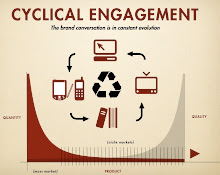We were hoping to avoid the whole "list thing" (everyone has a list, right?), but we figure any of you reading this can expand on it in your own way and share it with the rest of the blogosphere. So we'll start with a list, and then generate separate posts that feature the listed case studies speaking to each tenet. So enjoy.
1. This is not a popularity contest (be humble).
Life has become an extension of high school, which is why there is so much dissension in the workplace, and so many disconnects between brands and people. How do you think we got ourselves into a global economic crisis?
Let's not forget the point of being social: commonality. It's not just about you, it's about all of us, and creating what some call a "background of relatedness". It's precisely how our new President was elected.
Example: The Obama Campaign
2. Be real (share your experiences).
We also can't forget the importance of accountability and authenticity. Take responsibility not only for yourself, but for others around you. And when you speak, speak from the heart.
That said, people are fed thousands of advertising messages every day. We don't need better messages, we need better stories.
"Experience sharing" is what this is all about. Attach a product to an experience that's real. That'll get people talking about your brand. And buying your product.
Example: Yelp
3. It's not about being first to market, it's about being best to market.
The days of the internet gold rush are over. The speculative market is bust. We are left with two undeniable truths: brands and the stories behind those brands.
There are only five real stories to tell in the world (at least according to Shakespeare), and they've all been told numerous times. So narrate one of them with all the passion you can muster. And own it.
Example: American Express
4. Learn from your mistakes and those of others. Then help one another to improve the marketplace.
Adversity and defeat give us perspective. When we have perspective, we are successful.
If your market sector is heading south, then chances are so will your business. Marketplace stimulation is your best friend.
Example: eBay
5. Competition definitely breeds excellence. And leads to collective innovation.
Think it's counterintuitive for a "cool" brand with its own retail presence to join forces with the biggest retailer in the world? What about for that retailer to effectively allow an eCommerce provider to have a significant presence in its own stores?
Think again. Unlikely pairings are those that can spawn great successes.
Example: Apple, Wal-Mart & Amazon (peripherally)
6. You're only as good as right now.
Remember yesterday. Think about tomorrow. But show people the value of now.
And if you do more listening than talking, you'll be surprised by what you hear.
Example: Twitter
7. Do it with higher purpose.
If the intent is there, there is fulfillment in everything that we do. Even the little things.
Social media marketing is not only about experiences, but the common interest drivers that lead us into those experiences, things such as social, environmental or political advocacy.
Example: Target
8. As individuals, we are the sum of our parts.
If people are considered to be cogs, there is no removing them from the machine, since "it" operates autonomously.
So do your part and feed the machine. It might end up paying your bills.
Example: Wikipedia
9. Profit requires participation.
The Berlin Wall and Tiananmen Square were events representing incredible shifts in consciousness. These were not the work of one person, but many.
Business is no different. Allow each and every person - customers or employees - a voice, and enable him or her to share it. Then join the conversation and take action through equitable leadership.
Example: Dell/HP/Starbucks
10. Focus.
There are at least 22 specific channels of social media currently in use, with dozens more associated touch-points. It was only about 14 years ago that we were limited to print, broadcast and radio.
We've come a long way, but we've also managed to get in our own way as well. In reality, our experiences can mostly be recounted through a few specific details.
This is the challenge of any brand in its attempts to connect with people. As insightful as a brand experience can be, we need to be economic with the rhetoric that is used to bring people into that experience.
Example: Zappos
THE TAKEWAY...
Any successful business requires social responsibility.
Whether you're ready to admit it or not, who you are in life is who you are at work. Which means that if you can't get along internally and in "the outside world", your brand will suffer and therefore your business will suffer.
As rudimentary as this seems, it is still one of the most glaring issues in corporate America today.
That said, those who have chosen to hide behind computer screens or PDAs can speak in a variety of new ways. Of course, there is nothing more valuable than a smile and a handshake (or a Coke and a smile). Just that now, social media platforms might help lead people to get to the handshake. And a smile.
And a whole lot more...







